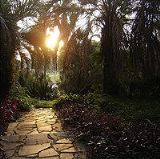
Porto Alegre Botanical Garden
Encyclopedia
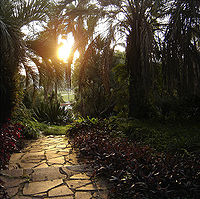
Rio Grande do Sul
Rio Grande do Sul is the southernmost state in Brazil, and the state with the fifth highest Human Development Index in the country. In this state is located the southernmost city in the country, Chuí, on the border with Uruguay. In the region of Bento Gonçalves and Caxias do Sul, the largest wine...
located on the street Salvador França, in Porto Alegre
Porto Alegre
Porto Alegre is the tenth most populous municipality in Brazil, with 1,409,939 inhabitants, and the centre of Brazil's fourth largest metropolitan area . It is also the capital city of the southernmost Brazilian state of Rio Grande do Sul. The city is the southernmost capital city of a Brazilian...
, Brazil
Brazil
Brazil , officially the Federative Republic of Brazil , is the largest country in South America. It is the world's fifth largest country, both by geographical area and by population with over 192 million people...
. Together with the Museum of Natural Sciences, the Botanical Garden is one of the most complete ones. This preservation area
Area
Area is a quantity that expresses the extent of a two-dimensional surface or shape in the plane. Area can be understood as the amount of material with a given thickness that would be necessary to fashion a model of the shape, or the amount of paint necessary to cover the surface with a single coat...
is also suitable for investigation, education and recreation. More than 100 species
Species
In biology, a species is one of the basic units of biological classification and a taxonomic rank. A species is often defined as a group of organisms capable of interbreeding and producing fertile offspring. While in many cases this definition is adequate, more precise or differing measures are...
can be found at this garden
Garden
A garden is a planned space, usually outdoors, set aside for the display, cultivation, and enjoyment of plants and other forms of nature. The garden can incorporate both natural and man-made materials. The most common form today is known as a residential garden, but the term garden has...
. Developing environmental educational activities to make people become aware of the importance of biodiversity
Biodiversity
Biodiversity is the degree of variation of life forms within a given ecosystem, biome, or an entire planet. Biodiversity is a measure of the health of ecosystems. Biodiversity is in part a function of climate. In terrestrial habitats, tropical regions are typically rich whereas polar regions...
are taking place here. It is possible to make guided tours of the garden. And temporary as well as permanent exhibitions are held here.
History
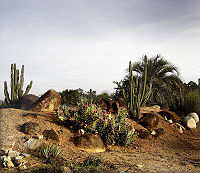
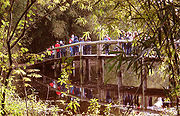
Porto Alegre
Porto Alegre is the tenth most populous municipality in Brazil, with 1,409,939 inhabitants, and the centre of Brazil's fourth largest metropolitan area . It is also the capital city of the southernmost Brazilian state of Rio Grande do Sul. The city is the southernmost capital city of a Brazilian...
dates back to the beginning of the nineteenth century, when Dom Joao VI, after creating the Rio de Janeiro Botanical Garden
Rio de Janeiro Botanical Garden
The Rio de Janeiro Botanical Garden or Jardim Botânico is located at the Jardim Botânico district in the "Zona Sul" of Rio de Janeiro....
, sent seedlings to Porto Alegre
Porto Alegre
Porto Alegre is the tenth most populous municipality in Brazil, with 1,409,939 inhabitants, and the centre of Brazil's fourth largest metropolitan area . It is also the capital city of the southernmost Brazilian state of Rio Grande do Sul. The city is the southernmost capital city of a Brazilian...
to establish another similar park in the city. Unfortunately these seedlings did not come to the capital, remaining trapped in Rio Grande
Rio Grande
The Rio Grande is a river that flows from southwestern Colorado in the United States to the Gulf of Mexico. Along the way it forms part of the Mexico – United States border. Its length varies as its course changes...
, where they were planted. The agriculturist Paul Schoenwald subsequently donated a plot of land to the state government to establish a green area, but the project was unsuccessful.
A third attempt would be made in 1882, when councilman Francisco Pinto de Souza presented a proposal for scientific exploitation of the area then known as the Várzea de Petrópolis, providing a garden and a promenade. Considered utopian, the plan was terminated and lay dormant for decades, only returning to consideration in the mid-twentieth century.
In 1953 the 2136 law authorized the selling of an area of 81.57 hectares, of which 50 hectares would be to create a park or botanical garden. A committee, which included prominent teacher and religious figure Teodoro Luís, was formed to develop the project, which began in 1957 with the first planting of selected species: a collection of palm trees, conifers and succulent. When opened to the public on September 10 of 1958, it already featured nearly 600 species.
Soon after, in 1962, was inaugurated the oven for cacti, in the'70s and the botanical garden was integrated into Fundação Zoobotânica Foundation, along with the Park Zoo and the Museum of Natural Sciences. This season began the collection of trees, with emphasis on families of ecological importance (Myrtaceae, Rutaceae, Myrsinaceae, Bignoniaceae, Fabales, Zingiberales, among others), thematic groups (condiments and scented) and forest formations typical of the state, and is launched a program for expeditions to collect specimens and seeds.
A project linked to the Program Pro-Guaíba allowed in the 90's an improvement in the infrastructure of the Botanical Garden, where nurseries were built for bromeliads, orchids, succulent, vines and cacti
Cacti
-See also:* RRDtool The underlying software upon which Cacti is built* MRTG The original Multi Router Traffic Grapher from which RRDtool was "extracted".* Munin -External links:******...
, and reforms have taken place in the center of visitors and the administration, beyond the creation of a seed bank.
Paleontology
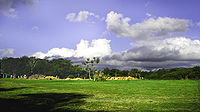
| Museums Geopark Geopark A Geopark is defined by the United Nations Educational, Scientific and Cultural Organization in its UNESCO Geoparks International Network of Geoparks programme as follows:... of Paleorrota Paleorrota Paleorrota , is a geopark located in the center of the Brazilian state of Rio Grande do Sul. The rocks and fossils found along the route date back to the times when there was only one supercontinent Pangaea.... . |
|
At the Museum of Natural Sciences, which is located inside the Porto Alegre Botanical Garden, there is an exhibition of fossils found in geopark
Geopark
A Geopark is defined by the United Nations Educational, Scientific and Cultural Organization in its UNESCO Geoparks International Network of Geoparks programme as follows:...
of paleorrota
Paleorrota
Paleorrota , is a geopark located in the center of the Brazilian state of Rio Grande do Sul. The rocks and fossils found along the route date back to the times when there was only one supercontinent Pangaea....
, as well as contributing to publications on the subject.

